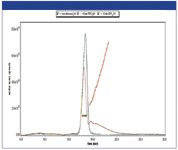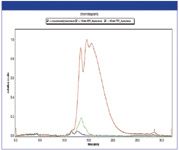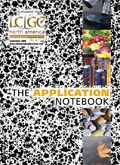IgG Aggregation Using Online Fluorescent Dye Detection in HP-SEC and AF4
To guide the development of aggregate free protein formulations, there is an urgent need for formulations, there is an urgent need for complementary methods which allow a sensitive detection, characterization, and quantification of different types of protein aggregates.
To guide the development of aggregate free protein formulations, there is an urgent need for formulations, there is an urgent need for complementary methods which allow a sensitive detection, characterization, and quantification of different types of protein aggregates. Our aim was to use size exclusion chromatography (SEC) and asymmetrical fow field flow fractionation (AF4) in combination with UV, fluorescence, and multi angle laser light scattering (MALS) detection to quantify and characterize monoclonal antibody (IgG) aggregates in heat stressed formulations. For fluorescence detection the extrinsic fluorescent dye Bis-ANS (600 nM) was added to the mobile phase and detected using an excitation of 385 nm and an emission of 488 nm.
The UV signal at 280 nm was used to calculate the relative amount of monomer and aggregates and the total recovery of the method using an extinction coefficient of 1.5 mL mg-1 cm-1 . SEC resulted in a better separation of monomer and dimers. However, the recovery was below 50% for the 80 °C stressed samples, due to aggregates larger than the exclusion volume of the column. With AF4 these larger aggregates could be analyzed and a higher recovery of > 90% was achieved. From the MALS and UV signal the molar mass of the monomer was calculated to be 150 kDa, the dimer 300 kDa and the larger aggregates higher than 400 kDa (Figure 1).

Figure 1: UV detection (280 nm) and molar mass calculated from the MALS signal of AF4 separation of non-stressed IgG, 10 min 75 °C stressed and 10 min 80 °C stressed IgG.
Bis-ANS fluorescence detection represents a highly sensitive method to identify aggregated IgG (Figure 2). Bis-ANS exhibits an increase in fluorescence in a hydrophobic environment, which is frequently found wherever proteins aggregate or change conformation. In conclusion, the combination of different detectors for SEC and AF4 analysis adds significant methodological comprehensiveness, thus achieving a reliable characterization of IgG samples.

Figure 2: Fluorescence detection (excitation 385 nm, emission 488 nm) of AF4 separation of non-stressed IgG, 10 min 75 °C stressed and 10 min 80 °C stressed IgG.
This note graciously submitted by T Andrea Hawe, PhD, and Wim Jiskoot, Leiden University, Leiden Amsterdam Center for Drug Research (LACDR), Netherlands.

Wyatt Technology Corporation
6300 Hollister Avenue, Santa Barbara, CA 93117
tel. (805)681-9009; fax (805)681-0123
Website: www.wyatt.com

SEC-MALS of Antibody Therapeutics—A Robust Method for In-Depth Sample Characterization
June 1st 2022Monoclonal antibodies (mAbs) are effective therapeutics for cancers, auto-immune diseases, viral infections, and other diseases. Recent developments in antibody therapeutics aim to add more specific binding regions (bi- and multi-specificity) to increase their effectiveness and/or to downsize the molecule to the specific binding regions (for example, scFv or Fab fragment) to achieve better penetration of the tissue. As the molecule gets more complex, the possible high and low molecular weight (H/LMW) impurities become more complex, too. In order to accurately analyze the various species, more advanced detection than ultraviolet (UV) is required to characterize a mAb sample.

.png&w=3840&q=75)

.png&w=3840&q=75)



.png&w=3840&q=75)



.png&w=3840&q=75)














